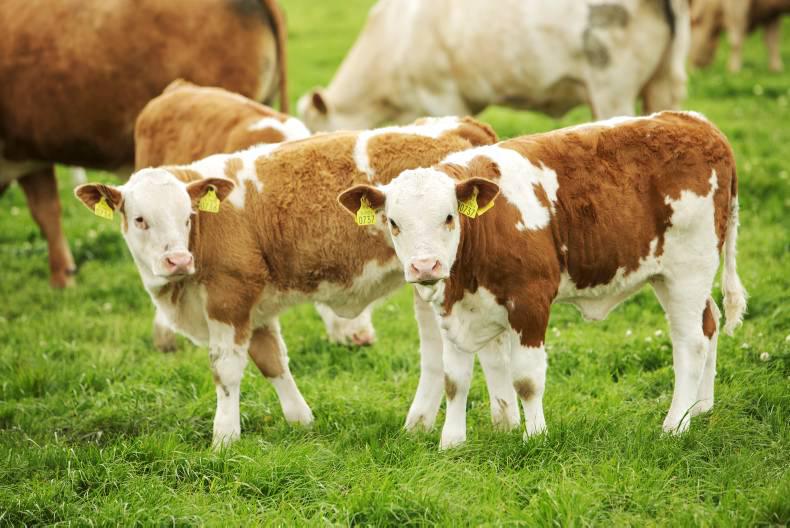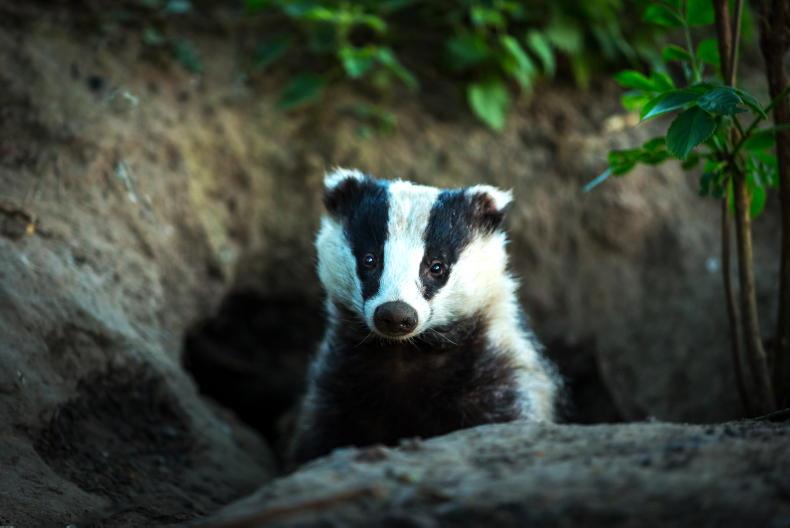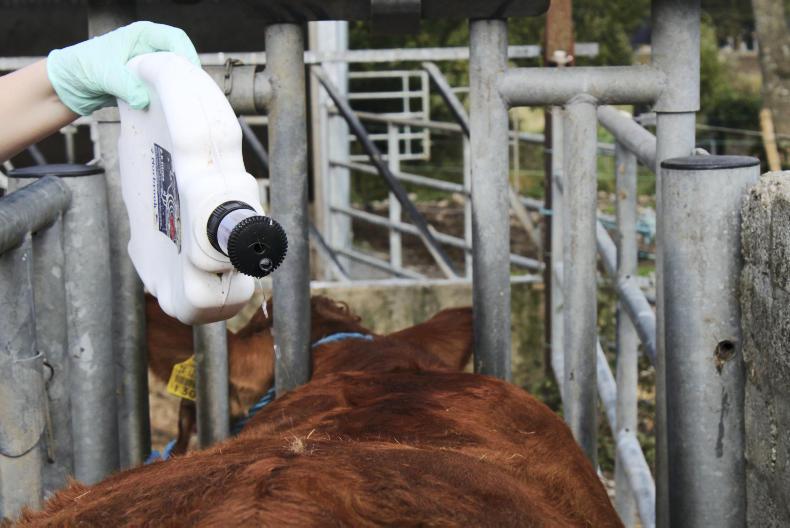A commonly asked question is how to determine the cause of pneumonia in a clinically affected case. A reply can only be accurate if supported by laboratory investigation, as IBR can look like pasteurella pneumonia, hoose can resemble viral pneumonia and, the early case, with just a fever, could be caused by a range of diseases. So where does pneumonia start or finish? Should a farmer take a chance and hope that cases won’t arise? Or should they vaccinate against just IBR, as it is a once-off shot that might provide enough protection? We will look at some of these questions with a view to formulating a best approach to the three Cs – the cause, consequences and control – of the most common killer of nearly all ages of cattle in Ireland – respiratory disease.
Pneumonia in weanlings has many contributing causes involving the animal, the environment, management and the various agents that cause lung infections (lungworm, viruses, bacteria and mycoplasmae). Stressful procedures such as dehorning, castration, weaning, sudden changes of nutrition or weather and housing can all suppress the immune response of the animal that is exposed to these agents. Thus a virus that might cause mild illness can suddenly have a more serious impact. Mixing of animals after purchase, or of various age groups within a herd, can also lead to exposure to a range of agents, resulting in a new spread of infection during this time of impaired immune response.
So what are the risks? Three-quarters of Irish herds are infected with IBR, a very high proportion have PI3 and RSV viruses, nearly all have Mannheimia (Pasteurella) haemolytica and Pasteurella multocida and possibly up to one-third of herds have Mycoplasma. Little is known about the prevalence of Histophilus somni in Ireland, though as a mortality causal agent it ranks similar to IBR in official reports.
While BVD eradication has diminished the number of persistently infected animals (PIs) that previously would have contributed to worsened respiratory disease, the disease has not yet gone away, as some farmers still retain PIs.
If you are keeping a closed herd, it is important to determine your disease profile, as this can allow you to tailor your vaccination programme, but if you are purchasing in from many/unknown sources you can probably assume you are at risk from all of the common agents and their relative importance can vary over time.
Management
While IBR can cause classical reddening of the nasal lining, a cough and runny eyes/nose, this can be confused, as disease progresses, with other pneumonia agents as the signs become less specific. While any farmer will recognise a pneumonia case that is gasping or panting or even those that begin with a cough, the more astute stockman will see the earlier impact, including animals that are not finishing their meals with the same voracious appetite or those that are “hollow”. Acute illness can lead to rapid deterioration and death if untreated. If in doubt, consult your vet early, as this leads to better treatment outcomes and facilitates the collection of samples that are invaluable in establishing an accurate diagnosis.
The longer-term consequences of pneumonia mean animals do not reach their genetic potential and the result is poor thrive or depressed milk yield in adult life. Subclinical losses, happening after the dust has settled, can often equal or exceed those suffered during the acute outbreak.
Control
Good stockmanship, in addition to the issues identified earlier, might also include watching animals closely for flank fill, coat lick marks, carefully observing each animal for respiratory rate and depth and ensuring that all animals that are lying, are moved to verify that they stretch on rising and that their demeanour is bright. This can help to identify cases earlier. It is important to conduct these evaluations under adequate light, which is especially relevant in housing. Studies have shown that poor light dramatically decreases a stockman’s capabilities; and delaying detection radically diminishes success rate of treatment and increases relapse rate.
Weaning should be conducted to a fixed protocol that minimises stress (staged partial removal of cows, creep feeding, no mixing of age groups), leaving castration/dehorning/transport to a separate time, and housing when settled. If purchasing, let the animals out to grass for at least 10 to 14 days before housing. This allows them recover from the stress of transport and reduces house-related transmission. It also allows vaccination programmes be instituted ahead of housing as well as appropriate parasite control (lice, worms and possibly fluke).
Environment
Improving the environment in animal housing cannot be over-emphasised. Housing should be conducted on a dry day on to loose straw bedding at a low stocking rate. Easy access to water and creep feed is essential to minimising stress by facilitating animals in their new environment. The building should be well ventilated and lit. Aspects of housing that maximise air flow (openings at the eaves, spaced sheeting/boarding, apical vents etc) while avoiding draughts and having good drainage are all important. Seek advice if you need to make changes or are intending to build.
Medication
Lungworm should always be eliminated from the list by the use of an effective anthelmintic dose at housing. A flukicide treatment may also be necessary, carried out at six to 10 weeks after housing and repeated at intervals determined by the product. Long-acting novel antibiotic injections effective against pneumonia, have recently been licensed for both treatment and prevention. Medication, using antibiotics, should only be used if no other viable option is available.
Vaccination
Vaccines against pneumonia fall into two broad categories – live vaccines and inactivated products. Dead vaccines are administered by injection and as a general rule are slow at inducing immunity. Thus it is necessary to organise vaccination well ahead of housing. Two injections are invariably required spaced approximately three to four weeks apart to give strong and lasting immunity. Viruses still play the greatest role in pneumonia outbreaks and husbandry strategies coupled with correct vaccination programmes can effectively reduce the economic impact of this crippling disease.
Live vaccines administered intranasally give more rapid onset of cover. Various vaccines are available (See Table 1). Pasteurella (Mannheimia) haemolytica is a common cause of pneumonia in housed cattle due to a stress-related increase in this bacterium in the lungs or secondary to viral infection. If untreated, animals die in a few days. A number of vaccines are available that contain Pasteurella (Mannheimia) haemolytica with one vaccine claiming protection against more strains. Mycoplasma is becoming more frequently diagnosed on Irish farms and it may be more common than official diagnostic rates suggest, as is the case for Histophilus somni. There is no vaccine for mycoplasma and control depends on improving ventilation and stocking rates and treating with a mycoplasma-effective antibiotic product.
Losses associated with a mild outbreak have been estimated at €50-€150/head in production losses and medication expenses, not to mention the subsequent subclinical losses. Full vaccination at €15-17/head certainly pays for itself many times over in the face of estimates like this. Management practices in conjunction with vaccination will assist in minimising losses. Antibiotics to control disease should really only be used as a last resort. Always consult your vet early and frequently for best advice on prevention and treatment.
Read more
Focus: Winter animal health
A commonly asked question is how to determine the cause of pneumonia in a clinically affected case. A reply can only be accurate if supported by laboratory investigation, as IBR can look like pasteurella pneumonia, hoose can resemble viral pneumonia and, the early case, with just a fever, could be caused by a range of diseases. So where does pneumonia start or finish? Should a farmer take a chance and hope that cases won’t arise? Or should they vaccinate against just IBR, as it is a once-off shot that might provide enough protection? We will look at some of these questions with a view to formulating a best approach to the three Cs – the cause, consequences and control – of the most common killer of nearly all ages of cattle in Ireland – respiratory disease.
Pneumonia in weanlings has many contributing causes involving the animal, the environment, management and the various agents that cause lung infections (lungworm, viruses, bacteria and mycoplasmae). Stressful procedures such as dehorning, castration, weaning, sudden changes of nutrition or weather and housing can all suppress the immune response of the animal that is exposed to these agents. Thus a virus that might cause mild illness can suddenly have a more serious impact. Mixing of animals after purchase, or of various age groups within a herd, can also lead to exposure to a range of agents, resulting in a new spread of infection during this time of impaired immune response.
So what are the risks? Three-quarters of Irish herds are infected with IBR, a very high proportion have PI3 and RSV viruses, nearly all have Mannheimia (Pasteurella) haemolytica and Pasteurella multocida and possibly up to one-third of herds have Mycoplasma. Little is known about the prevalence of Histophilus somni in Ireland, though as a mortality causal agent it ranks similar to IBR in official reports.
While BVD eradication has diminished the number of persistently infected animals (PIs) that previously would have contributed to worsened respiratory disease, the disease has not yet gone away, as some farmers still retain PIs.
If you are keeping a closed herd, it is important to determine your disease profile, as this can allow you to tailor your vaccination programme, but if you are purchasing in from many/unknown sources you can probably assume you are at risk from all of the common agents and their relative importance can vary over time.
Management
While IBR can cause classical reddening of the nasal lining, a cough and runny eyes/nose, this can be confused, as disease progresses, with other pneumonia agents as the signs become less specific. While any farmer will recognise a pneumonia case that is gasping or panting or even those that begin with a cough, the more astute stockman will see the earlier impact, including animals that are not finishing their meals with the same voracious appetite or those that are “hollow”. Acute illness can lead to rapid deterioration and death if untreated. If in doubt, consult your vet early, as this leads to better treatment outcomes and facilitates the collection of samples that are invaluable in establishing an accurate diagnosis.
The longer-term consequences of pneumonia mean animals do not reach their genetic potential and the result is poor thrive or depressed milk yield in adult life. Subclinical losses, happening after the dust has settled, can often equal or exceed those suffered during the acute outbreak.
Control
Good stockmanship, in addition to the issues identified earlier, might also include watching animals closely for flank fill, coat lick marks, carefully observing each animal for respiratory rate and depth and ensuring that all animals that are lying, are moved to verify that they stretch on rising and that their demeanour is bright. This can help to identify cases earlier. It is important to conduct these evaluations under adequate light, which is especially relevant in housing. Studies have shown that poor light dramatically decreases a stockman’s capabilities; and delaying detection radically diminishes success rate of treatment and increases relapse rate.
Weaning should be conducted to a fixed protocol that minimises stress (staged partial removal of cows, creep feeding, no mixing of age groups), leaving castration/dehorning/transport to a separate time, and housing when settled. If purchasing, let the animals out to grass for at least 10 to 14 days before housing. This allows them recover from the stress of transport and reduces house-related transmission. It also allows vaccination programmes be instituted ahead of housing as well as appropriate parasite control (lice, worms and possibly fluke).
Environment
Improving the environment in animal housing cannot be over-emphasised. Housing should be conducted on a dry day on to loose straw bedding at a low stocking rate. Easy access to water and creep feed is essential to minimising stress by facilitating animals in their new environment. The building should be well ventilated and lit. Aspects of housing that maximise air flow (openings at the eaves, spaced sheeting/boarding, apical vents etc) while avoiding draughts and having good drainage are all important. Seek advice if you need to make changes or are intending to build.
Medication
Lungworm should always be eliminated from the list by the use of an effective anthelmintic dose at housing. A flukicide treatment may also be necessary, carried out at six to 10 weeks after housing and repeated at intervals determined by the product. Long-acting novel antibiotic injections effective against pneumonia, have recently been licensed for both treatment and prevention. Medication, using antibiotics, should only be used if no other viable option is available.
Vaccination
Vaccines against pneumonia fall into two broad categories – live vaccines and inactivated products. Dead vaccines are administered by injection and as a general rule are slow at inducing immunity. Thus it is necessary to organise vaccination well ahead of housing. Two injections are invariably required spaced approximately three to four weeks apart to give strong and lasting immunity. Viruses still play the greatest role in pneumonia outbreaks and husbandry strategies coupled with correct vaccination programmes can effectively reduce the economic impact of this crippling disease.
Live vaccines administered intranasally give more rapid onset of cover. Various vaccines are available (See Table 1). Pasteurella (Mannheimia) haemolytica is a common cause of pneumonia in housed cattle due to a stress-related increase in this bacterium in the lungs or secondary to viral infection. If untreated, animals die in a few days. A number of vaccines are available that contain Pasteurella (Mannheimia) haemolytica with one vaccine claiming protection against more strains. Mycoplasma is becoming more frequently diagnosed on Irish farms and it may be more common than official diagnostic rates suggest, as is the case for Histophilus somni. There is no vaccine for mycoplasma and control depends on improving ventilation and stocking rates and treating with a mycoplasma-effective antibiotic product.
Losses associated with a mild outbreak have been estimated at €50-€150/head in production losses and medication expenses, not to mention the subsequent subclinical losses. Full vaccination at €15-17/head certainly pays for itself many times over in the face of estimates like this. Management practices in conjunction with vaccination will assist in minimising losses. Antibiotics to control disease should really only be used as a last resort. Always consult your vet early and frequently for best advice on prevention and treatment.
Read more
Focus: Winter animal health









SHARING OPTIONS